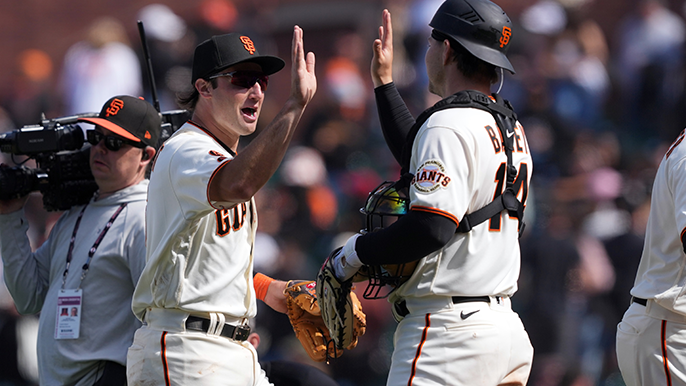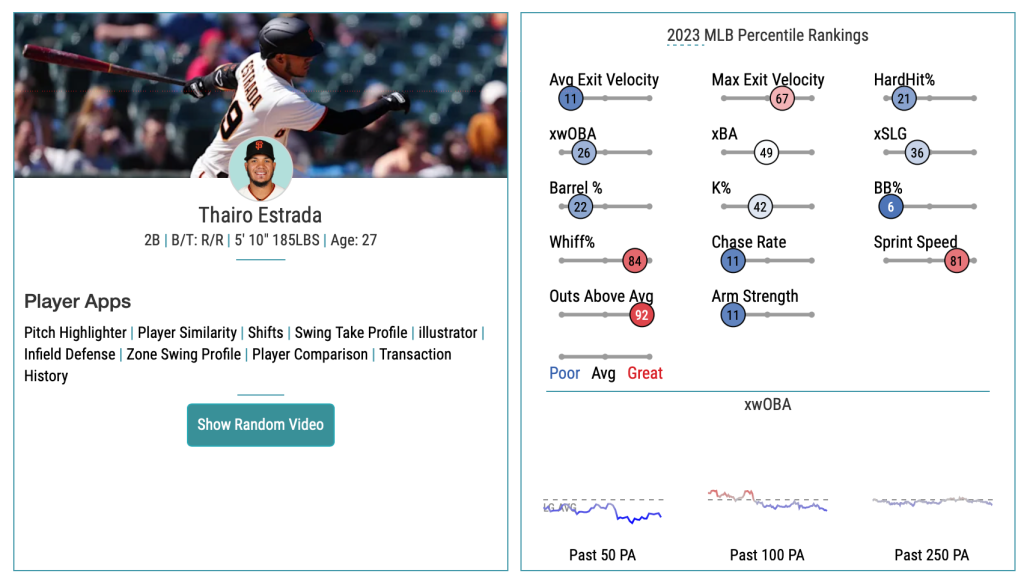
Even after dropping two of three to the Pirates, the Giants won four of their last five series in May, finishing the month 17-12.
Just twice last season did the Giants finish a month over .500. This May is the best month they’ve had since they went 18-10 in a September surge that brought the club to .500 last year. Before that, SF went 14-7 last April to start the season.
It might not be, but this feels different than both of those stretches.
Last September, the Giants took advantage of a fluky stretch of poor competition and were extra motivated to finish a lost season strong. In April, the opening month, Joc Pederson carried the offense with six home runs in 16 games.
During this stretch, San Francisco (28-28) clicked all-around. Rotation, bullpen, up and down the order, veterans, rookies. They could win 14-4 or 3-1. They weren’t overly reliant on one player or one style.
The pitching staff, which was supposed to be the Giants’ strength heading into the season, posted an overall 3.39 ERA — third-best in May. Even with injuries to several key hitters, the Giants lineup produced at about a league-average rate.
That combination allowed San Francisco to sweep last year’s National League champions, take a road series over both Central divisions’ first place clubs.
How much they can continue replicating their solid all-around play is the question. Is this a blip, or something bigger?
The pitching staff is for real
The best bullpen unit since 2010 was the 2013 Atlanta Braves, who posted a season ERA of 2.46. For that club, a prime Craig Kimbrel led MLB with 50 saves and placed in the top-five in Cy Young voting.
Before Wednesday’s loss to Pittsburgh, San Francisco relievers posted a 2.46 ERA in May. They also had the fifth-best FIP in the month — an indicator of sustained success.
This group isn’t going to be the most dominant ‘pen in over a decade, but it is full of established arms. Camilo Doval, the likely reliever of the month, is legit. Taylor Rogers has looked like himself since throwing his glove in the trash. His brother has a 2.00 ERA. John Brebbia and Scott Alexander are professional out-getters. And adding Luke Jackson could provide even more options.
Giants relievers rarely walk batters and have dramatically improved at keeping the ball in the park. In their best stretch, when the Giants won 10 of 13 games, the bullpen posted a 0.78 ERA.
No bullpen is quite that good. But the way the Giants relievers have pitched in May is much closer to what they looked like in March and April — when they sported a 6.15 ERA.
And then there’s the starting rotation, the expected strength of the roster heading into the season. Sean Manaea and Ross Stripling have obviously disappointed, but there’s not much evidence to suggest Logan Webb, Anthony DeSclafani and Alex Cobb are outperforming their abilities.
As long as that trio continues to be as competitive as any, the Giants’ rotation should be tenable. And with Kyle Harrison factoring in soon, it has the potential to be much more than that.
Rookie regression?
May was defined by the energy and excitement Casey Schmitt and Patrick Bailey brought to the team. Both 24-year-olds broke into the league like gangbusters and very well may remain with the club for the rest of the season.
Schmitt is hitting .325 with a .799 OPS and plus defense across three infield positions. With 27 hits in 22 games, he’s already earned a daily spot in SF’s lineup.
Bailey caught a bullpen game shutout and has already hit a home run from each side of the plate. He has 13 hits in 11 games. Even in a small sample, a .914 OPS at the major league level is no joke for a guy who needed just 28 games in the minors to earn a promotion this year.
This is where the record scratches.
Bailey was stuck at High-A Eugene last year as a 23-year-old. He hit .225 there and was even worse as a right-handed hitter. He had as many doubles and home runs as a righty in his first 13 MLB plate appearances as he did in 70 chances in 2022.
His hitting production, at least as a right-hander, is going to cool off.
So will Schmitt’s. The defensive wizard has a batting average on balls in play of .379 (league average is .297). Schmitt is hitting the ball hard often, but he’s also getting lucky.
His impressive bat-to-ball skills have allowed for an insanely aggressive plate approach, but pitchers will adjust by throwing him more balls out of the zone. Will he be able to avoid chasing them?
At some point, Schmitt and Bailey will slump. Almost all rookies do. How deeply they struggle, and how they handle inevitable failure at the big-league level, will be fascinating to watch.
While that exciting pair of rookies are likely punching above their weight, the Giants other two rookie position players may be more stable bets to either keep producing or produce better. Brett Wisely’s at-bats have looked more confident recently, and his .216 BABIP suggests better results are coming. Blake Sabol, since his 1-for-12 start, has been a hitting machine.
Sabol, Schmitt and Bailey are each in the top-15 in Fangraphs WAR among National League rookies. San Francisco is going to keep getting production out of its youngsters, but there will probably be speed bumps along the way.
Breakout star bound to get knocked down a peg
Thairo Estrada has been the Giants’ most valuable player so far, registering a team-high 2.0 fWAR.
He absolutely could finish as the team MVP. He’s an all-around player who can impact winning on the base paths and in the field. But the production from the plate might not continue quite at the same level he’s been at.
Estrada is similar to Schmitt in that he doesn’t take enough walks, but his contact skills have made up for that aggression. He chases — and makes more contact — with an above average amount of pitches outside of the zone. And when he does connect, he’s rarely barreling up the ball.

How does a player in the 21st percentile of hard-hit rate and 11th percentile in average exit velocity hit .301 through 47 games? Speed and a pinch of serendipity.
Estrada puts the ball in play frequently, and his speed puts pressure on the defense. He has 10 infield hits already this year, a function of his athleticism and hand-eye coordination. He’s also improved his ability to elevate the ball.
Estrada’s .371 BABIP is almost identical to Schmitt’s. That’s not going to hold forever. Even independent of the current wrist injury that has Estrada on the IL, the infielder is probably closer to a .275 hitter than a .300 one.
Here’s the situation
Criticism of lackluster offense is often reductive, reactionary and results-based. When the Giants have a game in which they leave a bunch of runners on base, cries of “they’re too home run dependent” ring. When the opposite happens, they “don’t play enough small ball.”
No team wants to hit fewer home runs. Every team has games when they feel they were one big hit away from breaking it open.
Manager Gabe Kapler has repeatedly talked about how he wants his batters to have the same approach no matter the situation. Seeking a good pitch to drive and trying to hit a line drive up the middle works regardless of how many outs there are, he reasons.
In May, the Giants hit .275 with runners in scoring position — sixth in MLB. They kept the line moving with players who put the ball in play more consistently (which frequently turned out to be rookies).
That was a stark contrast from March and April, when SF was 26th in batting average with RISP.
Perhaps the truth is somewhere between the .275 and .233 averages. But SF will probably also hit closer to the 46 home runs they smacked in the first month compared to the 30 from May going forward. That decrease likely had to do with sluggers Joc Pederson, Mike Yastrzemski, Austin Slater and Thairo Estrada missing time in May.
The upshot: the Giants should continue to produce, one way or another, crooked innings at a competitive rate.

